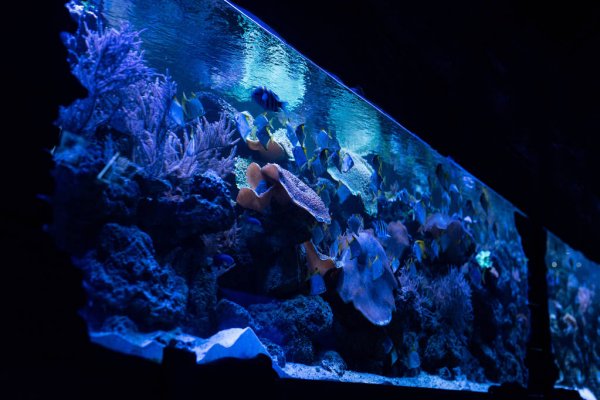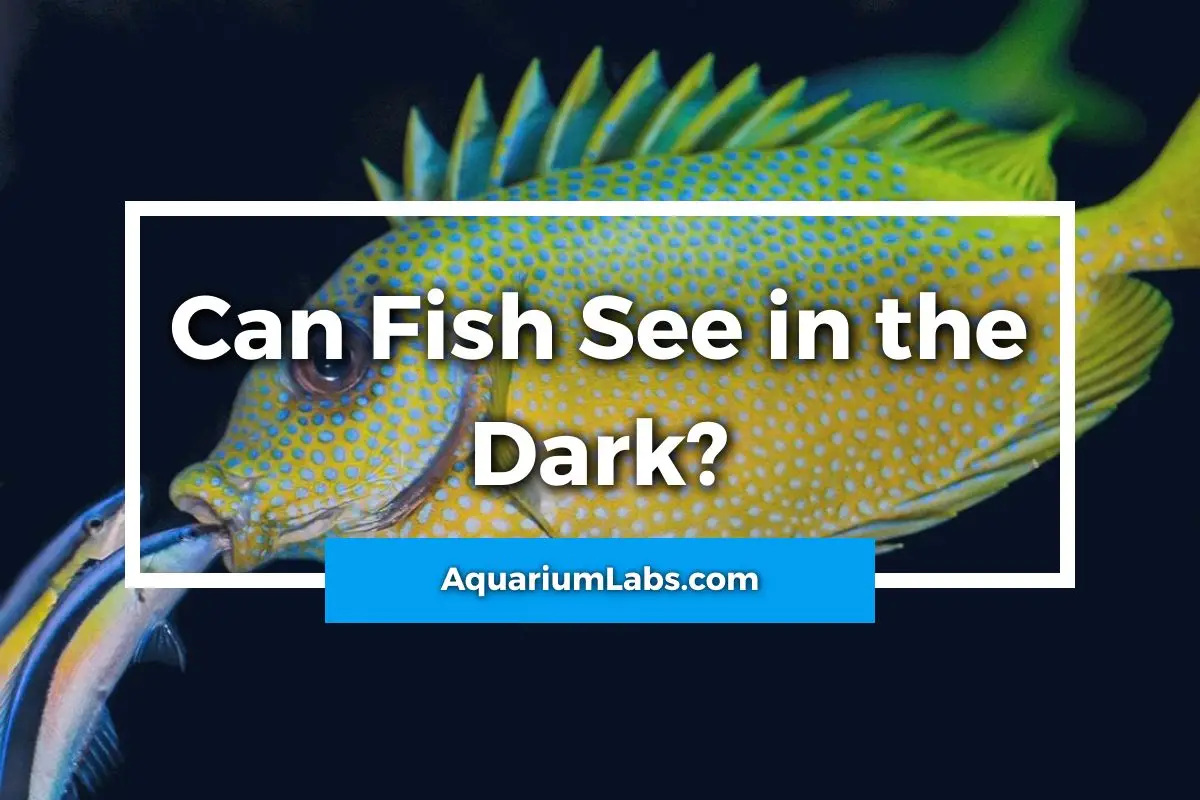When the lights go out, and it’s time for your aquarium fish to sleep, most species simply slow down and find a place to rest. But many of you have probably wondered whether your fish actually sleep. After all, they can’t close their eyes…
Do some feed instead? What about active nocturnal fish? Can fish see in the dark? And if not, what do fish do when the aquarium lights go out and night hours begin?
How Do Fish See in the Dark?
As it turns out, some fish can see in the dark! Night vision isn’t exclusive to land predators and humans with the right goggles. Some fish, such as many sharks, also have a version of night vision, with reflective guanine crystals lining the eye directly behind the retina. This allows light to bounce back into the retina, enhancing their vision acuity in low light conditions.
Many animals have senses that we humans lack entirely, and fish are no exception! Fish can see using their eyes, and they can detect sound normally. However, they also have the ability to detect movement and water pressure changes thanks to their lateral line. The lateral line is often visible as a row of pored scales along their sides called neuromasts, running from the head all the way to the tail of the fish.
Even fish that can’t see in the dark may be able to detect obstacles like rocks and other fish using the lateral line. Most fish rely heavily on their eyes, but others, such as the Blind Cave Tetra (Astyanax mexicanus), can use their lateral line along with their sense of smell to navigate in the dark!

Other fish species have even weirder senses! Many fish see not only light and pressure but electrical fields as well! Sharks and rays have tiny jelly-filled organs called Ampullae of Lorenzini running along their bodies that sense the faint electrical current created by animal muscles. Even when hunting fish at night, they can lock onto prey without light.
Several aquarium fish species have a similar ability; only they create electricity using specialized organs and cells. The Electric Eel is the most famous example, but many knifefish and the Electric Catfish also do this. Their electric field warps when other fish or barriers pass through it, allowing them to move normally in the dark and catch prey.
Deep-Sea Fish and the Dark
The surface of the ocean is constantly bathed in powerful light from the sun. Yet that light has its limits, and fish living in the sea often have to make use of dim light – or no light at all!
Red light is one of the first wavelengths to be filtered out as sunlight hits the ocean. Within the first few meters, red’s intensity is greatly reduced, and by 200 meters, red light is entirely nonexistent in this zone. Blue light penetrates water the furthest, hence the ocean’s overwhelmingly blue color. But even blue light is absorbed by the immensity of the ocean as you travel deeper into the dark.

In ideal conditions, light may penetrate as far as 1,000 meters before darkness takes over. But there is rarely any strong lighting beyond 200 meters; photosynthesis isn’t possible in this zone since many of the most useful wavelengths have been lost.
In the deep ocean environment, fish eyes often evolve to be larger to take advantage of what little light is possible. Fish are often colorless since patterns are of little use. Or they may be a bright red in color! At first, this seems like a strange discovery until you realize that red pigments look black in the deep sea.
Red is effectively a camouflage for deep-sea fish against animals that can see in the darkness. Light occasionally penetrates the dark when bioluminescent animals create it. This light can signal the presence of prey or predators like anglerfish, which use glowing fishing lures to attract meals.
What do Aquarium Fish Do at Night?
In the dark, fish typically slow down and prepare for sleep. But for some fish like catfish and knifefish, the fun is only beginning.
Can Fish Find Food in the Dark?
It’s best not to feed your aquarium fish at night unless they are nocturnal species that are too shy to eat during the day. Nocturnal fish almost always have sensitive olfactory organs, giving them a heightened sense of smell. Catfish whiskers are one example; these fish use them to navigate using both touch and smell in the darkness.
But even fish without heightened organs may be able to find food in the dark. Many smells can be detected much more readily in the water than in the air because water is much denser than air. A strong smell along with changes in the water current can lead fish directly to food, especially in an area as small as most fish tanks.
Many aquarium fish can see in the dark or the near-darkness of your home. If you have faint lighting from computers, street lights, and other plugged-in devices, many fish species can see from that. Catfish often have the guanine layers behind the retina I mentioned earlier; if their eyes shine like a cat’s at night, then that fish likely has night vision!
Should I Leave the Tank Lights Off at Night?
Around 12 hours of darkness is essential for all animals to sleep, and fish are no different. Without sleep, aquarium fish will become increasingly stressed and lose the ability to repair the small amounts of damage that accumulate during the daytime active period.
How Long Should the Tank Lights Stay Off?
There is no set number of hours to leave the aquarium lights off, but 8 to 12 hours is a standard period of darkness. This replicates the natural day-night cycle of the sun that fish sleep depends on. If this cycle is disrupted or made inconsistent in timing, you can see stress responses arise in skittish behavior, dulled colors, and daytime sleeping. Science shows that fish can act very similarly to a human that’s sleep-deprived!
Related: Aquarium Lighting Guide
Some aquarists find that they can’t turn off the aquarium light at a regular time. Perhaps you have a changing work schedule, a family that needs attending to – or you simply forget easily! If you have scheduling issues, then a light timer might be a good addition to your tank.
A timer will give your fish a regular dark period so they can rest naturally. And then, the light also returns at set hours, so their circadian rhythms can attune themselves properly.

Can I Use Blue Tank Lights at Night?
Blue light LEDs are often sold as a low light feature for aquarium hoods so you can see them “in the dark.” A lot of websites and even fish keepers use them because they believe that blue light isn’t disruptive to fish sleep. Unfortunately, this isn’t true; blue light is actually the main regulator of animal circadian rhythms. It’s why we sell blue light glasses to prevent blue wavelengths from computer screens from disrupting our sleep schedules.
Bathing an aquarium in blue light instead of leaving your fish in the dark isn’t healthy for them. Nor does blue accurately reflect moonlight, as the advertising claims. And even if it did, the full moon doesn’t shine every night. Let your fish normally sleep at night, and they will be healthier for it!

So Can Fish See in the Dark?
Can fish see in the dark? The answer is that some fish see in the dark, especially predatory aquarium fish, but not all. Most rely on vision along with their ears for sound and lateral lines for changes in the water pressure. Other ways include enhanced senses of smell, touch, and even abilities that we humans can barely imagine, like electrical detection.
And remember that blue LED lights are not wise to use for an entire evening, no more than it would be enjoyable for you. Fish like true darkness for sleeping purposes, and the blue wavelengths are still disruptive to sleep patterns.
So regardless of your fish species, give them a break from the light with a proper 8 to 12 hours of rest. This way, you’ll be greeted by healthy, perky pets in your tank the following morning!
Fish Keeping FAQs:

